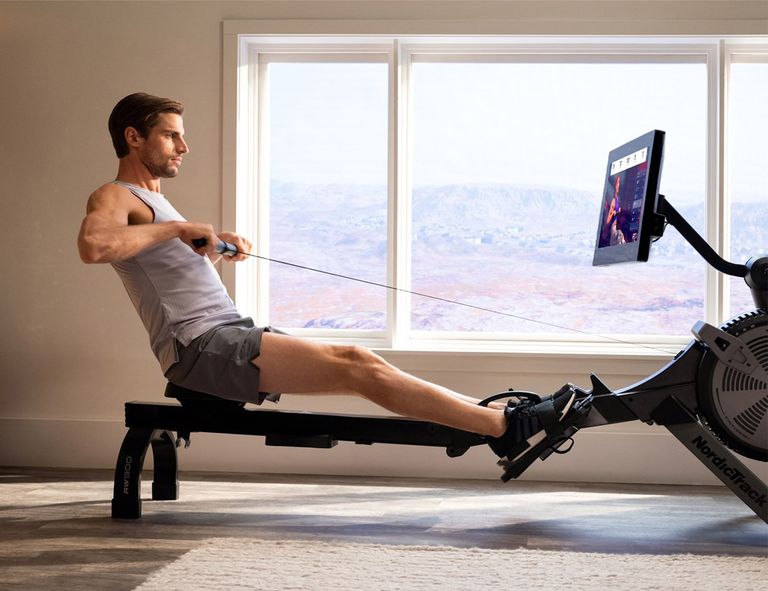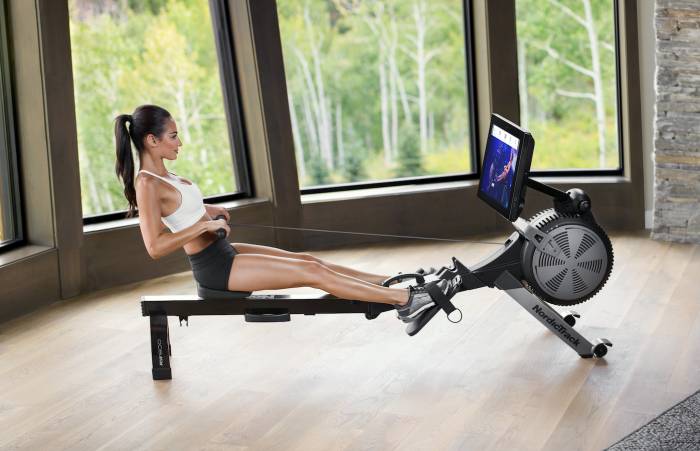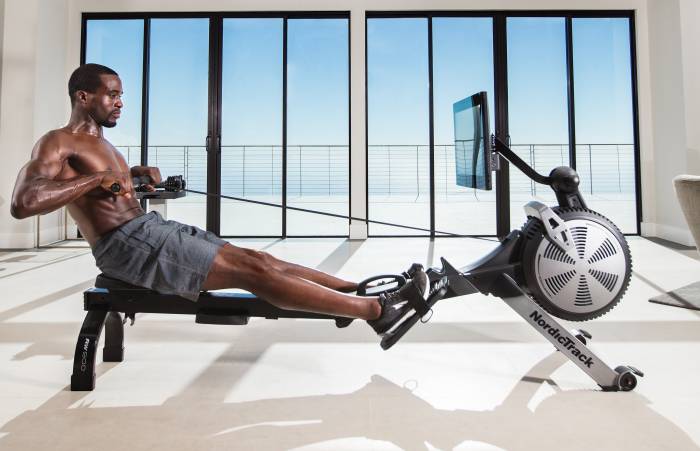If you’re exploring the world of fitness equipment, rowing machines are likely to have caught your attention.
These impressive machines, often understated compared to the more flashy treadmills or ellipticals, offer a comprehensive workout that goes beyond the conventional.
As a personal trainer and fitness enthusiast, I’m here to shed light on these powerful machines and how they have a profound link with heart health.
Rowing machines simulate the action of watercraft rowing, providing a full-body workout. This isn’t just about building your biceps or toning your abs – rowing machines engage almost every major muscle group in your body, from your legs to your core to your arms.
The benefits of rowing machines don’t stop at muscle toning and strength building. They offer one crucial advantage that’s less discussed but equally significant – the benefit to cardiovascular health.
Understanding the Cardiovascular System
Before we delve deeper into how rowing influences heart health, it’s essential to understand what the cardiovascular system is and why it is crucial.
Simply put, your cardiovascular system consists of your heart and all the blood vessels in your body. It’s a vast transportation network responsible for delivering oxygen and nutrients to your cells and removing waste products like carbon dioxide.
Regular exercise is paramount to keep this system running smoothly and efficiently. Cardiovascular exercise, in particular, boosts the health of your heart and blood vessels. It can help reduce your risk of heart disease and other conditions like high blood pressure, cholesterol issues, and even type 2 diabetes.
When you engage in cardiovascular exercise, you increase your heart rate, which in turn promotes blood circulation. Over time, this helps strengthen your heart muscles, reduces resting heart rate, and improves overall heart function. As someone who has been in the fitness industry for a long time, I’ve witnessed firsthand the remarkable impact cardiovascular exercise can have on people’s lives.
In the next section, we’ll delve into the specifics of how rowing contributes to this incredibly important aspect of health. So, if you’re ready to give your heart the love it deserves, stay tuned!
How Rowing Works

When you first sit on a rowing machine, you might not realize the comprehensive workout that lies ahead. The rowing motion may seem simple, but it’s a multi-faceted exercise that engages several muscle groups simultaneously.
The rowing stroke consists of two primary parts: the drive and the recovery. During the drive, you push with your legs, engage your core, and then pull with your arms. In the recovery phase, this process is reversed. As you perform these movements, you’re working out your lower body (quadriceps, hamstrings, and glutes), your core (abs and back), and your upper body (arms, shoulders, and back).
Now, how does this relate to a cardiovascular workout? When you engage in rowing, you’re elevating your heart rate and increasing your oxygen consumption. The body’s response to sustained rowing is to pump more blood to the muscles in use. This cyclical process means your heart is working hard, thereby giving it a good workout and improving cardiovascular health.
The Cardiovascular Benefits of Rowing Machines
So, we know that rowing machines provide a solid cardiovascular workout. But what does that mean for heart health in concrete terms? Regular use of a rowing machine strengthens your heart and improves your body’s ability to use oxygen. More efficient oxygen use leads to improved stamina and endurance, making your daily physical activities easier to perform.
Rowing machines offer an excellent form of cardiovascular exercise that increases heart rate to a level that promotes fat burning, thus contributing to weight loss. This is crucial because maintaining a healthy weight is important for overall heart health. Being overweight puts more strain on your heart, making it work harder to pump blood around your body. By promoting weight loss, rowing indirectly contributes to improved heart health.
Moreover, full-body engagement in rowing also helps maintain healthy blood pressure levels. Regular rowing sessions can lead to lower resting blood pressure, which reduces the risk of cardiovascular disease over time.
The benefits of rowing machines for heart health are impressive. They offer an efficient and effective means of improving cardiovascular fitness, building endurance, promoting weight loss, and maintaining healthy blood pressure. Stay tuned for the next part, where we’ll discuss additional perks of rowing for heart health and overall well-being.
The Benefits of Rowing vs. Other Cardio Workouts

Now let’s take a moment to compare rowing to other popular cardio workouts, such as running or cycling. Each of these exercises have their unique benefits, but rowing stands out in several ways.
One of the primary advantages of rowing is that it’s a low-impact workout, meaning it’s easier on your joints compared to running. This makes rowing an excellent option for individuals of all fitness levels, including those with joint issues or injuries.
Secondly, unlike cycling, which mainly focuses on the lower body, rowing is a total body workout. It engages both your upper and lower body, making it an efficient way to get a full-body workout in less time. Don’t get me wrong stationary bikes have many benefits, so for some people exercise bike is a better choice.
Also, rowing is an excellent choice for interval training. High-intensity interval training (HIIT) on a rowing machine can burn a significant amount of calories and boost heart health.
Lastly, rowing can be a great alternative for those who find other forms of cardio monotonous. The distinctive rhythm and full-body engagement of rowing often make it more engaging and less monotonous than other forms of steady-state cardio.
It’s important to note that the best exercise is often the one you enjoy and will stick with. If you enjoy rowing and it fits into your lifestyle, it can be an excellent option for cardiovascular fitness. In the next section, we’ll look into some additional health benefits of rowing beyond heart health.
Practical Tips for Cardiovascular Training with a Rowing Machine
Starting a rowing routine and sticking to it is often the biggest challenge. But with a few practical tips, you’ll be well on your way to a healthier heart through rowing.
Starting a Rowing Routine
If you’re new to rowing, start slow. Initially, aim for 10-15 minutes of rowing, gradually increasing your time as your fitness level improves. Begin each session with a warm-up of light rowing to prepare your body for the more intense work ahead.
In the beginning, focus on mastering your form. The rowing stroke can be broken down into two main parts: the drive and the recovery. The drive is the work portion of the stroke, where you push with your legs, lean back slightly, and pull the handle towards your chest. The recovery is the rest portion, where you extend your arms, lean forward from the hips and bend your legs to slide back up to the catch.
Effective Rowing Workouts
To maximize the benefits of your workout, ensure you’re using your legs for power. Rowing should be about 60% legs, 30% core, and 10% arms. Your legs are stronger than your arms, so let them do the heavy lifting.
Also, don’t rush your stroke rate. A lower stroke rate (around 20-30 strokes per minute) often promotes a more powerful stroke and helps maintain form.
Finally, incorporating interval training into your rowing workout can be particularly beneficial for boosting cardiovascular fitness. Try alternating between 1 minute of intense rowing and 1-2 minutes of relaxed rowing.
Understanding Heart Rate Zones
Understanding heart rate zones can take your training to the next level. These zones are a percentage of your maximum heart rate (MHR), which can be roughly estimated as 220 minus your age.
Zone 1 is about 50-60% of your MHR, where you’re working at a comfortable pace and can carry on a conversation. This zone is good for warm-ups and cool-downs.
Zone 2 is 60-70% of your MHR, a pace that is a little harder but still manageable. This zone builds basic endurance and promotes fat burning.
Zone 3 is 70-80% of your MHR. This is the zone where you’re pushing yourself harder but still not at maximum effort. This zone improves aerobic capacity and cardiovascular fitness.
Zone 4 is 80-90% of your MHR. At this level, you’re pushing hard but can still sustain your effort level. This zone helps improve anaerobic capacity and threshold.
Zone 5 is 90-100% of your MHR, the maximum effort you can sustain. This zone should be reached only for short periods during interval training.
By understanding these zones, you can structure your rowing workout to fit your specific fitness goals, whether it’s burning fat, improving endurance, or boosting cardiovascular health.
In the next section, we’ll discuss some precautions and considerations to keep in mind when using rowing for cardiovascular fitness.
Which Type of Rowing Machine is Best for Cardiovascular Health?
When it comes to rowing machines, not all are created equal. Each type offers a unique set of benefits, and what might be ideal for one person might not be for another. It’s essential to consider individual needs and circumstances when choosing a rowing machine, especially when focusing on cardiovascular health.
1. Young Person
For young people, who typically have good physical strength and endurance, air or water rowers might be the best options. These types of rowers offer a more realistic rowing experience and can provide a high-intensity workout that young individuals can handle.
The resistance in these machines increases with the speed of your rowing; the harder and faster you row, the more resistance you feel. This is fantastic for boosting cardiovascular health and strength conditioning.
2. Obese Person
For someone who is overweight, low-impact workouts are often recommended to minimize stress on the joints. A magnetic rowing machine could be a good choice in this case.
Magnetic rowers provide a smooth, consistent, and quiet rowing experience. You can adjust the resistance level to fit your current fitness level, making it easier to start your exercise journey. As you progress, you can increase the resistance level to continue challenging your cardiovascular system.
3. Senior
For older adults, safety, comfort, and low impact are often top priorities. In this case, a hydraulic rower could be the ideal option.
Hydraulic rowing machines offer adjustable resistance and provide a gentler workout, putting less stress on the joints compared to other types. The tension on the hydraulic cylinder can be adjusted to a level that provides a good workout without overtaxing the individual.
To sum it up, when it comes to enhancing cardiovascular health, the “best” rowing machine depends on the individual’s fitness level, age, and health status. Before starting any new exercise program, it’s a good idea to consult with a health or fitness professional to make sure the regimen is safe and suitable for your needs.
Scientific Evidence Supporting Cardiovascular Benefits of Rowing
Rowing is widely recognized by fitness and health professionals as an effective form of cardiovascular exercise. But it’s not just word of mouth; there’s also plenty of scientific evidence to back this up.
Study: Rowing Versus Other Forms of Exercise
Finally, a study from Harvard University compared the cardiovascular benefits of several different types of exercise, including rowing. The study found that rowing burned more calories than many other activities, thereby potentially reducing the risk of heart disease.
Link to study: Rowing Versus Other Forms of Exercise
Remember, while these studies show promising results, the benefits of rowing can vary based on factors like your age, fitness level, and how often and intensely you exercise. Always consult with a healthcare provider before beginning any new exercise regimen.
Conclusion
There’s no doubt about it – rowing is a powerhouse when it comes to cardiovascular exercise. The way it combines strength training and cardio into one fluid motion makes it a uniquely effective way to bolster your heart health.
Throughout this article, we’ve delved deep into how rowing works in your cardiovascular system and its benefits for heart health, endurance, and weight loss. We’ve also discussed how it stacks up against other popular forms of cardio and looked at some practical tips for incorporating rowing into your workout regimen.
Scientific research, as we’ve seen, backs up these claims, showing that rowing is indeed a proven method for improving cardiovascular fitness.
So, if you’re looking to pump up your heart health, why not give rowing a try? Whether you choose to row on the water or on a rowing machine at home or the gym, you’re in for a full-body workout that’s hard to beat. And your heart will thank you.
Thanks for joining me on this journey through the world of rowing. Keep rowing, stay healthy, and let’s continue to explore the fitness world together!
